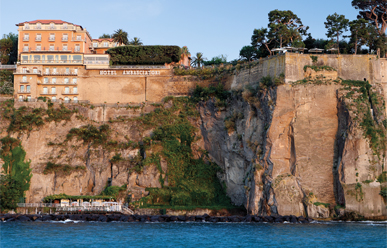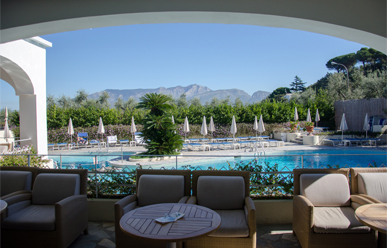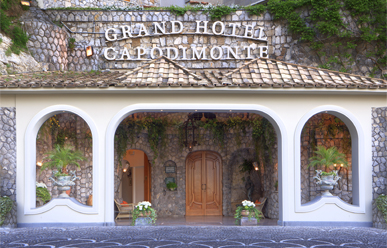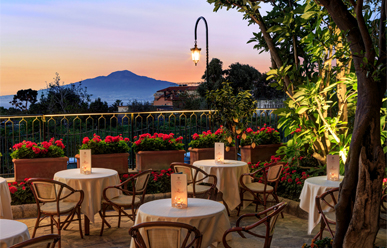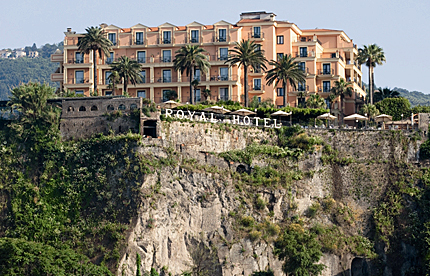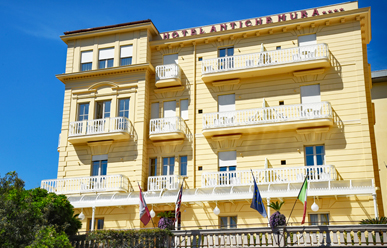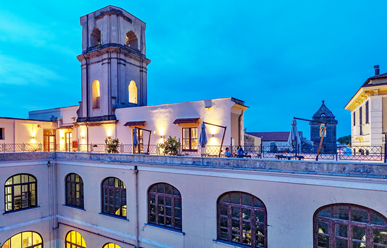
Sorrento
The Land of Colors
Considered the gateway to the Amalfi Coast, Sorrento charms visitors with ancient stone architecture, lush valleys and fragrant citrus groves.
Narrow streets twist and turn through this quaint city, which is nestled among rocky cliffs overlooking picturesque beaches. With buildings dating to the 11th century, glorious gardens and panoramic views of the Bay of Naples, Sorrento exudes Mediterranean romance.
Sorrento Hotels
Featured Deals
Venice, Florence, Rome and Sorrento: Your Way
Daily Breakfast
Executive Member Benefit at Select HotelsSorrento, Rome, Florence and Venice: Your Way
Daily Breakfast
Executive Member Benefit at Select HotelsSorrento and Rome: Your Way
Daily Breakfast
Executive Member Benefits at Select HotelsSorrento, Rome and Venice: Your Way
Daily Breakfast
Executive Member Benefit at Select HotelsRome and Sorrento: Your Way
Daily Breakfast
Executive Member Benefit at Select Hotels
More About Sorrento
Known for its beautiful views of the Amalfi Coast, the city of Sorrento in southern Italy is delightful. From the towns of Centro Storico to Piazza Tasso or Corsa Italia, you will find antique shops, restaurants, and souvenir shops. You can spend a great amount of time here while admiring the amazing architecture and sipping on a refreshing limoncello beverage. The city has a quaint fishing village, Marina Grande, that offers local seafood. The St. Anthony Basilica is a centuries-old church dedicated to Sorrento’s patron saint. The Cloister of San Francesco overlooks the Gulf of Naples and offers music performances. Journey outside of Sorrento, where you can explore historical and archaeological sites such as Pompeii, Herculaneum, and Mount Vesuvius. Enjoy the scenery by boat as you take a day trip to the Island of Capri.
The news is usually wonderful for the weather. Sheltered by the Lattari Mountains arcing east to west across the peninsula and inland from the Amalfi Coast, and exposed to cool breezes from two bays, the Sorrentine Peninsula enjoys a climate that is among the mildest in Italy; the temperature rarely falls below 50°F in winter, or climbs above 90°F in summer. In winter many hotels close, from November to March. As for rain, or what the locals call passione de Pasqua ("tears of passion" at Easter), it's rare although weeklong storms can strike.

Capri and Blue Grotto : The Blue Grotto is a cave that can only be entered by boat and is best visited earlier in the day for optimal lighting. The cave is part of the island of Capri. Capri is a small island just off the coast and is a day trip from Sorrento by ferry.
Beach Clubs : There are four beach clubs in the city, where you can rent a sun lounger or a deck chair. Many have umbrellas and on-site food is usually available.
Sedile Dominova : Since 1877, this building has been a trade union, representing all the different artisans of the city. Built in the fifteenth century, Sorrento aristocracy were the original residents. Its beautifully preserved frescoes are a highlight.
Piazza Tasso : The central business and commercial area in Sorrento. Once the sun sets, the locals stroll the area. There are many shops, cafés and restaurants located here. In addition, the Baroque Church del Carmine is also here.
Content provided by Costco Travel experts. Copyright © Costco Travel. All rights reserved.
Enjoy a two-hour guided tour of the world-famous archaeological and historical site of Pompeii, the Roman town buried under the eruption of Mount Vesuvius in 79 A.D. This buried city was rediscovered in the 16th century, but exploration only began in 1748. Work continued systematically through the 19th century up to the most recent excavations, aimed at restoring and attributing the proper value to the ancient city and its exceptional archeological heritage. The archeological area of Pompeii extends over 66 hectares, of which 49 have been excavated and 12 are open to the public. With its excavated area and the preservation state of its buildings, Pompeii can be considered the only archaeological site that gives the real image of a Roman city.
After lunch (own expense), transfer to Mount Vesuvius to discover why the locals have been both fascinated and frightened by Europe’s oldest active volcano for almost 2,000 years. In 79 A.D., Vesuvius stood 3 kilometers high and its last eruption took place in 1944. Visitors can reach Mount Vesuvius by car, but must walk the last 700 meters to reach the crater, standing roughly 1,281 meters high. Your guide will take you on an adventurous hike up this one-of-a-kind attraction to view the surrounding area and the crater beneath your feet. Walk around the edge of the crater and enjoy the fantastic view over the Gulf of Naples.
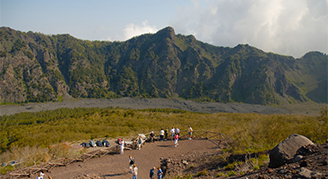
Tour Duration: Approximately 8 hours
Tour Highlights
- Pompeii
- Mount Vesuvius
Tour Inclusion(s)
- 8-hour round-trip chauffer with uniform, English speaking driver
- 4-hour authorized and licensed, English speaking private guide
- Advance purchase entrance tickets and reservations to Pompeii and Mount Vesuvius
- Daily
- Except: National holidays
- 9:00a.m.
Meet in hotel lobby 5 minutes before pick-up time.
- Hotel Lobby
- Mercedes Car or Van
- No penalties for cancellations made up to 72 hours prior to service; cancellations made within 72 hours will be charged 100% penalty. Pre-purchased tickets are non-refundable.
Enjoy a two-hour tour of the world-famous archaeological and historical site of Pompeii, the Roman town buried under the eruption of Mount Vesuvius in 79 A.D. This buried city was rediscovered in the 16th century, but exploration only began in 1748. Work continued systematically through the 19th century up to the most recent excavations, aimed at restoring and attributing the proper value to the ancient city and its exceptional archeological heritage. The archeological area of Pompeii extends over 66 hectares, of which 49 have been excavated and 12 are open to the public. With its excavated area and the preservation state of its buildings, Pompeii can be considered the only archaeological site that gives the real image of a Roman city.
After a break for lunch (own expense), you’ll continue to the archaeological site of Herculaneum, which, like Pompeii, was buried during the eruption of Mount Vesuvius in 79 A.D. Today, Herculaneum lays claim as the best-preserved archaeologically excavated site of the entire region. You will be mystified by the preservation of its villas, baths, shops and Forum. Herculaneum portrays a clear idea of what life was like more than 2,000 years ago.
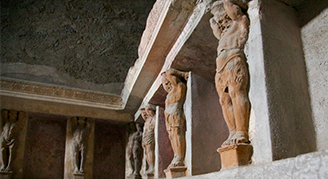
Tour Duration: Approximately 8 hours
Tour Highlights
- Pompeii
- Herculaneum
Tour Inclusion(s)
- 8-hour round-trip chauffer with uniform, English speaking driver
- 4-hour authorized and licensed, English speaking private guide
- Advance purchase entrance tickets and reservations to Pompeii and Herculaneum
- Daily
- Except: National holidays
- 9:00a.m.
Meet in hotel lobby 5 minutes before pick-up time.
- Hotel lobby
- Mercedes Car or Van
- No penalties for cancellations made up to 72 hours prior to service; cancellations made within 72 hours will be charged 100% penalty. Pre-purchased tickets are non-refundable.
Positano: Positano was a port of the Amalfi Republic in medieval times, and prospered in the 16th and 17th centuries. But by the mid-19th century, more than half the population emigrated, primarily to Australia. Positano began to attract large numbers of tourists in the 1950s after John Steinbeck published his essay about Positano in Harper's Bazaar, writing: "Positano bites deep .... It is a dream place that isn’t quite real when you are there and becomes beckoningly real after you have gone.” Enjoy this magical coastal village and wander its streets, browsing its artisan boutiques, shore-front stores and gourmet delicatessens.
Amalfi: The town of Amalfi was the capital of the Maritime Republic of Amalfi, an important trading power in the Mediterranean between 839 and 1200. In the 1920s and 1930s, Amalfi was a popular holiday destination mainly for the British upper class and aristocracy. Today, Amalfi is the main town of the coast on which it is located, the Costiera Amalfitana (a UNESCO World Heritage Site), and is an important tourist destination together with other towns on the same coast. Wander through the streets of this coastal gem, while you visit the highlights and try the coast’s most renowned treat: the infamous Limoncello.
Ravello: Ancient legend still recounts that it was to Ravello, with its breathtaking view of the Mediterranean and the dramatic Amalfi coastline, that Satan transported Jesus during his second temptation to show the beauty of the world's kingdoms. Historically, the town has served as a destination for artists, musicians, and writers, including Richard Wagner, M. C. Escher and Virginia Woolf, all of whom have either written or composed while staying in the town. Choose to take a journey through wonderful gardens, magical churches and arguably the most incredible panoramas in Europe.
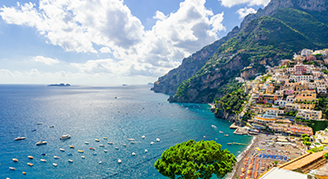
Tour Duration: Approximately 8 hours
Tour Highlights
- Positano
- Amalfi
- Ravello
Days of Operation
- Daily
- Except: National holidays
Departure Time(s)
- 9:00
a.m.
Meet in hotel lobby 5 minutes before pick-up time.
Pick-Up Point(s)
- Hotel lobby
Type of Vehicle(s)
- Mercedes Car or Van
Cancellation Policy
- A 100% cancellation fee will apply for no-shows or if the reservation is cancelled within five days prior to arrival. Pre-purchased tickets are non-refundable.
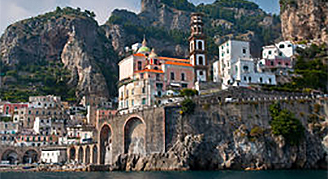
Tour Duration: Approximately 7 hours, including a 3 hour tour of Capri and transfers
Days of Operation:
- Daily
- Except: National holidays
- 9:00a.m.
- Hotel lobby
- Mercedes Car or Van
- No penalties for cancellations made up to 4 days prior to service; cancellations made within 4 days will be charged 100% penalty. Pre-purchased tickets are non-refundable.
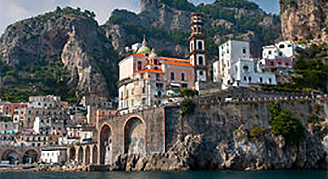
Tour Duration: Approximately 9 hours, including a 6 hour tour of Capri and transfers
Days of Operation:
- Daily
- Except: National holidays
- Hotel lobby
- Mercedes Car or Van
- No penalties for cancellations made up to 4 days prior to service; cancellations made within 4 days will be charged 100% penalty. Pre-purchased tickets are non-refundable.



